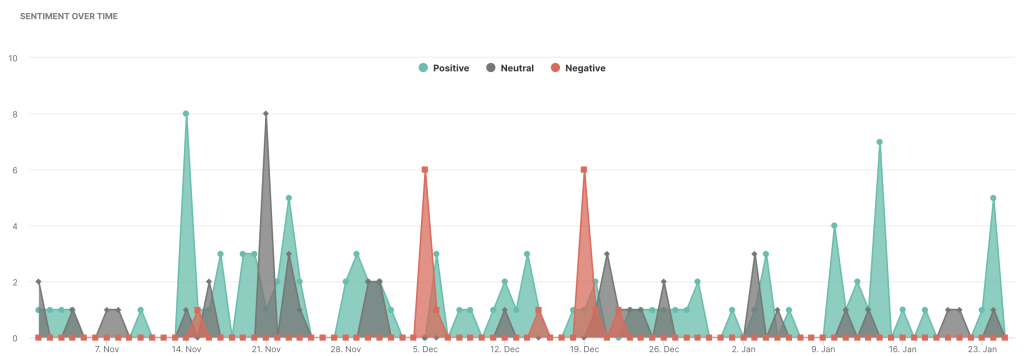Customer feedback is hugely important for modern businesses. Thanks to new technology, you can gathered and analyze it more efficiently than ever before.
? Read Media Monitoring: The Ultimate Guide
One such helpful tool is online sentiment analysis. This can help companies determine how customers feel about their products, services, brand, and other aspects of their business.
Let’s take a look at what it is, how it works, and what benefits it can bring.
What is Online Sentiment Analysis?
You can use sentiment analysis, also called opinion mining or emotion AI, to determine the emotion (sentiment) expressed by a text and to process this information at scale.
It applies natural language processing (NLP), artificial intelligence, and statistical analysis to data gathered from sources such as customer surveys, social media, or online reviews. It provides businesses with valuable insights into how customers feel about them and their operations. These insights are then used to inform business decisions.
Levels and types of sentiment analysis
A business can conduct online sentiment analysis at several levels. The authors of a recent article published in the Artificial Intelligence Review distinguished the following levels of sentiment analysis:
- Document level
- Sentence level
- Phrase level
- Aspect level
At each of these levels, a sentiment score is assigned to the relevant portion of the text (whole document, individual sentences or phrases). In aspect analysis, however, it is assigned to selected topics or ‘aspects’ covered in the text.
This scoring may focus on the polarity of a text (positive, negative, neutral) which, in turn, may be measured on a more or less fine-grained scale. You can expand the three categories into five, including very positive, positive, neutral, negative, and very negative.
Alternatively, it may be based on specific emotions, such as happy, sad, or disappointed. Which method you choose will depend on the data you want to collect.
Read How to Conduct Sentiment Analysis to Improve Customer Experience?

For example, an internet phone service provider may want to know how users who left their reviews on Trustpilot assess the overall quality of the service. In that case, it may be advisable to focus on the polarity at the ‘document’ level. Specifically how many reviews are negative, how many are positive, and so on. If, however, the company was interested in the reaction to a particular aspect of the service, such as ease of use, an emotion-led, aspect-based analysis would be more suitable (so, are people angry about this feature? Are they pleased?).
How does Online Sentiment Analysis Work?
Online sentiment analysis tools can be fully automated or implement rules specified by humans. A hybrid approach, combining features of these two, is also possible.
Since you’re likely to use an existing solution, we won’t bore you with the really technical distinctions. Instead, just keep in mind that rule-based sentiment analysis relies on lexicons of positive and negative words. They are used to calculate the sentiment score of a text.
The automated sentiment analysis, meanwhile, relies on machine learning algorithms. They determine the sentiment expressed by a text based on the words and their order. The hybrid approach combines features of these two. It makes the most of the transparency of the rule-based analysis and the vast processing power of automated tools.

Business Applications of Online Sentiment Analysis
Sentiment analysis can help companies make sense of vast quantities of unstructured data related to the perception of their brand, products, services, and other aspects of the business. Some particular implementations include:
Customer feedback analysis
Modern businesses shouldn’t underestimate the importance of customer feedback. It can help them meet the needs of customers in the face of huge market competition. Not to mention that it impacts the perception of a brand in powerful ways.
The feedback can come from a variety of sources. These can be voice of customer programs, NPS surveys, social media monitoring, online reviews, opinion forums, and more. Accessing this data and making sense of it is crucial. According to Bright Local, the majority of customers read and write business reviews. They also note that reviews influence their purchase decisions.
The amount of information available from these sources is vast. It is almost impossible for humans to process, without assistance from a powerful data management platform. Online sentiment analysis tools are there to help you with the task. With them, you can monitor how your customers feel about your business. Also, how these perceptions vary across various consumer groups, and how they change over time.
Market research
Sentiment analysis isn’t just for customer reviews – you can apply it to materials such as market reports and business journals. It’s a great way to gain insights into new trends, and importantly, you can use it to research your competitors.
Let’s go back to the internet phone service provider from our previous example. The marketing team could research the cloud based phone systems and apply sentiment analysis to establish which features customers value the most.
It can also look at their reviews, and figure out what they struggle with. That gives your team the opportunity to really highlight their own strengths in these areas, attracting disappointed customers from your competitors.
Read How to Do Market Research With a Media Monitoring Tool?
Brand reputation management
Consumer reviews published in opinion forums and on social media can impact a business in positive, as well as negative ways. The previously mentioned study from Bright Local showed that most customers would not engage with a business that has less than a three star rating.
So, monitoring the reviews that customers leave about your business online definitely pays off! Online sentiment analysis tools will make it easier for you to keep an eye on the perception of your brand. You can identify which sources influence it the most, be it in positive or negative ways.
Of course, brand reputation management isn’t just about collecting the data – you need to act on the results, which takes us to the next point in our discussion.
Crisis prevention and continual improvement
As long as you’re keeping an eye on customer sentiment, you’re in a good position to spot a crisis before it gets out of control. It doesn’t always have to be about major problems. Identifying minor issues and addressing them promptly will keep you safe from any reputational damage.
Perhaps our internet phone service provider finds that many customers have been recently posting negative reviews of its cloud PBX phone system. Catching this early on thanks to online sentiment analysis tools, the company might realize a new update has come with some new bugs. By spotting this quickly, they can fix the problem and even open a dedicated service line for those who’ve encountered the problem. Positive reviews of its response may counterbalance the initial negative feedback.
Finally, sentiment analysis can help you improve your marketing and advertising strategies. You can analyze responses to your past and current campaigns. You can find out if your marketing team has shown enough creativity while working remotely or if it takes more effort to deliver satisfactory results.
How to Implement Sentiment Analysis?
Sentiment analysis tools are available from a variety of online vendors. Alternatively, you can build your own software. Both approaches have their advantages and disadvantages that you should consider before making your choice.
Reaching for a ready-made tool is usually the more convenient and economical choice. The same is true in other areas of business. Ready-made solutions, such as Determ makes life easier by saving considerable amounts of time and money.
However, if you have very specific needs, you might find building one from scratch – or purchasing one that’s highly customizable – is better in the long run.

Work in Progress…
Given the current state of machine learning and NLP technologies, existing online sentiment analysis tools are not perfect. There are still issues and challenges. Especially when it comes to machines’ capacity to deal with the complexity of human language.
Still, the sentiment analysis software available today can definitely provide you with a lot of valuable information. You can easily transform this into handy data lists for marketing teams, and respond to how your target market is actually feeling rather than making your best guess.
Remember that technological progress continues, making the tools more and more effective. Getting in now means you’ll reap the early benefits, and stay ahead of the curve as it continues to improve. If you haven’t tried online sentiment analysis yet, it’s time to do it and see what benefits it can bring to your business!
Richard Conn is the Senior Director for Demand Generation at 8×8, a leading communication platform with integrated contact center, voice, video, chat functionality and features including virtual office phone services. He is an analytical & results-driven digital marketing leader with a track record of achieving major ROI improvements in fast-paced, competitive B2B environments. Richard has also written for other domains such as Invoca and Yesware. Check out his LinkedIn.



